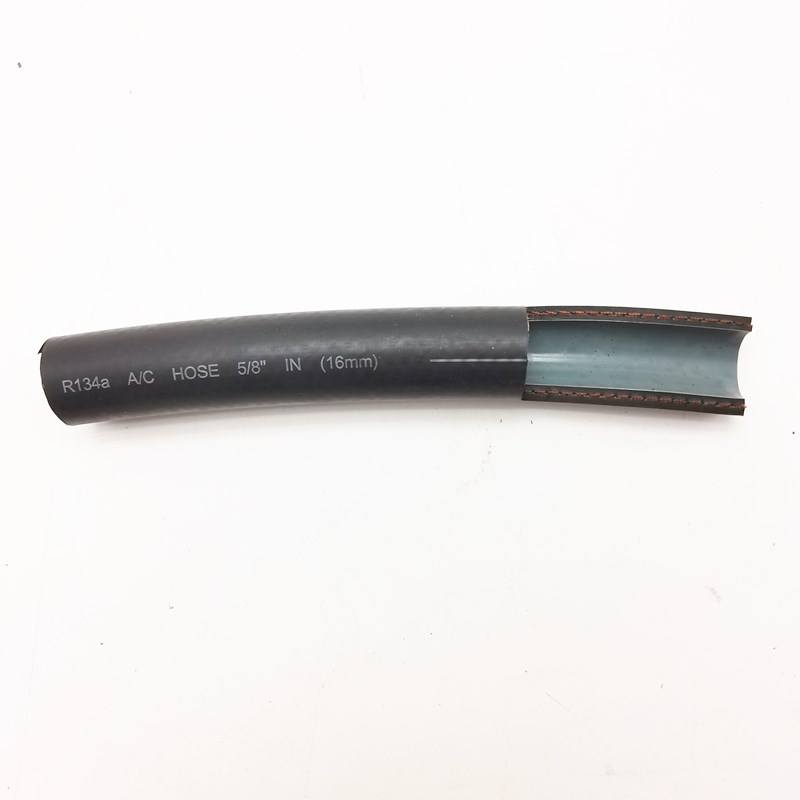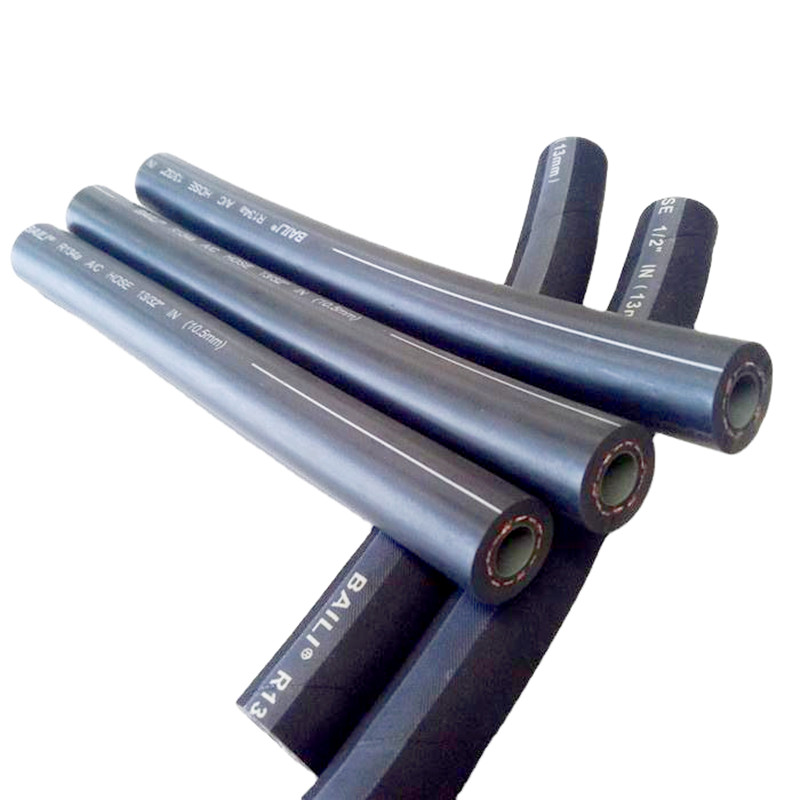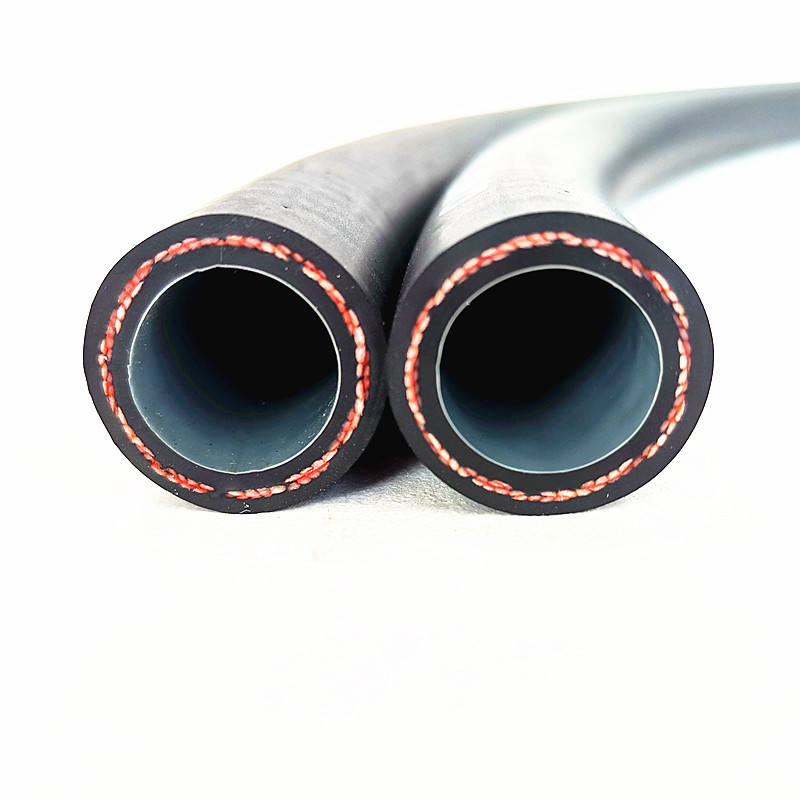Agu . 06, 2025 00:40 Back to list
Durable 3/8 Rubber Air Hose | Braided & Heat-Resistant
In the vast landscape of industrial and automotive components, the humble hose is often an unsung hero. Yet, selecting the right one is critical for safety, efficiency, and system longevity. This guide provides a comprehensive deep-dive into the rubber air hose 3 8, exploring everything from its advanced manufacturing processes and technical specifications to real-world applications and key purchasing considerations. We'll spotlight the SAE J2064 4 Layer A/C Hose Type E (A10 & A20) as a benchmark of quality and performance in this category.
Industry Insight: The global industrial hose market is projected to reach USD 16.5 billion by 2028, growing at a CAGR of 4.5%. This growth is driven by increasing industrialization, stringent safety regulations, and the demand for high-performance materials in sectors like automotive, manufacturing, and chemical processing. A high-quality rubber air hose 3 8 is a cornerstone of this market, valued for its durability and versatility.
Technical Deep Dive: Understanding the Anatomy of a High-Performance Rubber Hose
Not all rubber hoses are created equal. The performance of a hose is dictated by its materials, construction, and adherence to industry standards. A premium rubber air hose 3 8, such as the SAE J2064 Type E, is a multi-layered marvel of engineering designed for specific, demanding tasks.
Material Science & Construction: The Core of Durability
The construction of a modern rubber air hose is a layered system where each component has a specific function:
- Inner Tube: This is the primary layer in contact with the medium (e.g., air, refrigerant). For A/C applications, materials like Chloroprene (CR) with a polyamide barrier are used to achieve extremely low permeability, preventing refrigerant loss. For general air use, Nitrile (NBR) or EPDM rubber is common for its oil and abrasion resistance.
- Reinforcement Layer: This is the muscle of the hose. High-tensile synthetic yarn, such as Polyester (PET) or Aramid, is tightly braided around the inner tube. This is what defines a braided rubber hose, giving it the strength to withstand high working pressures and resist kinking. The braid angle and density are precisely controlled to balance flexibility and burst strength.
- Outer Cover: The external shield. EPDM (ethylene propylene diene monomer) rubber is a popular choice for the cover due to its exceptional resistance to heat, ozone, UV radiation, and weathering. This makes it a superior heat resistant rubber hose suitable for harsh engine bay environments or outdoor industrial use.

The Unseen Advantage: The Manufacturing Process of a Rubber Air Hose 3 8
The journey from raw rubber compound to a finished, reliable hose is a testament to precision manufacturing. This process, which combines extrusion, braiding, and vulcanization, ensures every hose meets exacting standards like SAE J2064.
A specialized rubber compound is heated and forced through a die to form the seamless inner tube over a flexible mandrel, which sets the precise inner diameter (ID).
High-tensile synthetic yarn is braided around the inner tube using high-speed machinery. The number of carriers and braid angle are critical for pressure rating.
The protective outer layer (e.g., EPDM) is extruded over the reinforcement braid, forming a complete hose structure.
The hose is wrapped and placed in an autoclave. High-pressure steam or heat chemically cross-links the rubber molecules, giving the hose its final strength, flexibility, and durability.
Post-curing, hoses undergo rigorous testing: pressure tests (working and burst), dimensional checks, and material analysis per ISO/ANSI standards before being marked and cut.
Comparative Analysis: Rubber Air Hose Specifications
The "size" of a hose involves more than just its diameter. Key parameters determine its suitability for an application. While the **rubber air hose 3 8** (ID of 3/8 inch or ~10mm) is a popular all-rounder, other sizes like the **1/4 rubber air hose**, **1/2 id rubber hose**, and **3/4 id rubber hose** serve different flow rate and pressure needs.
| Hose Size (ID) | Typical ID (mm) | Typical OD (mm) | Typical Working Pressure (PSI) | Typical Burst Pressure (PSI) | Common Applications |
|---|---|---|---|---|---|
| 1/4 rubber air hose | 6.3 | 13.5 | 300 | 1200 | Pneumatic die grinders, small air tools |
| rubber air hose 3 8 | 9.5 | 17.5 | 300 | 1200 | Automotive A/C, general purpose air tools, impact wrenches |
| 1/2 id rubber hose | 12.7 | 21.0 | 250 | 1000 | High-flow air tools, shop air supply lines, water transfer |
| 3 4 inch rubber hose | 19.0 | 28.5 | 200 | 800 | Heavy-duty industrial air/water, main compressor lines |
Performance Visualized: SAE J2064 4 Layer A/C Hose Type E
Data visualization helps clarify why a premium product like the SAE J2064 Type E hose stands out. Its design is optimized for the demanding environment of automotive air conditioning systems, outperforming standard hoses on key metrics.
Performance Benchmark: Baili SAE J2064 vs. Standard Rubber Hose
Material Composition of SAE J2064 Type E Hose
Application Scenarios: Where Performance Matters Most
The versatility of the rubber air hose 3 8 makes it a staple across numerous industries. However, its true value is revealed in applications where failure is not an option.

Automotive Sector: The Ultimate Proving Ground
From the professional garage to the OEM assembly line, rubber hoses are indispensable.
- Air Conditioning Systems: This is a primary application for the SAE J2064 hose. It must withstand constant vibration, extreme temperatures, and high pressure cycling of R134a or R1234yf refrigerants. Its low permeability is critical to prevent costly and environmentally damaging leaks.
- Power Steering: A robust power steering rubber hose must handle hydraulic fluid pressure and be resistant to oil and heat, ensuring smooth and safe vehicle control.
- Air Brakes: For commercial vehicles, a rubber air brake hose must meet stringent DOT (Department of Transportation) standards. These hoses, often paired with specialized rubber air brake hose fittings, are life-critical components.
Industrial and Manufacturing Environments
In factories and workshops, a reliable rubber air hose 3 8 powers a wide array of pneumatic tools. It must resist abrasion from being dragged across concrete floors, exposure to cutting oils, and the pressure demands of tools like impact wrenches and sanders. A competitor like the gates rubber hose is also common in this space, highlighting the need for manufacturers to differentiate on durability and specialized features like higher heat resistance.
Customer Success Story: A Case for Quality
Client: Pro Automotive Service, a multi-location auto repair chain.
Challenge: The chain was experiencing frequent A/C hose failures with generic aftermarket parts, leading to repeat customer visits, warranty claims, and damaged reputation. The primary issue was hose hardening and cracking due to engine bay heat.
Solution: They switched to Baili's SAE J2064 Type E heat resistant rubber hose for all A/C repairs. The hose's EPDM cover and 135°C temperature rating provided superior resilience.
Result: Over 18 months, warranty claims related to A/C hose failure dropped by 95%. Technicians reported the hose was easier to install due to its optimal flexibility. The client solidified its reputation for quality repairs, directly attributing the improvement to the reliability of the new component. This showcases a tangible ROI from investing in a superior-spec hose.
Customization, Trust, and Support: Partnering for Success
Beyond the product itself, a reliable supplier offers comprehensive support. At Baili Hose, with over 15 years of manufacturing expertise, we understand that one size doesn't fit all.

- Customization: We offer custom solutions for length, color, branding, and even specific pressure or temperature requirements for unique applications.
- Delivery & Logistics: With a typical delivery cycle of 20-30 days for a full container111, we ensure your production lines and inventory levels are maintained.
- Quality Assurance: All our hoses, including the flagship rubber air hose 3 8, come with a comprehensive warranty and are backed by our ISO 9001 certified quality management system.
- Expert Support: Our engineering team is available to help you select the perfect hose for your application, ensuring optimal performance and safety.
Frequently Asked Questions (FAQ)
EPDM (Ethylene Propylene Diene Monomer) is superior for outdoor applications and as an outer cover due to its excellent resistance to heat, ozone, and weathering. NBR (Nitrile Butadiene Rubber) is prized for its exceptional oil and fuel resistance, making it ideal for the inner tube of hoses that may be exposed to oily compressed air or fuel vapors.
SAE J2064 is a rigorous standard specifically for automotive air conditioning hoses. It specifies strict requirements for material composition, construction, dimensions, and performance, including extremely low refrigerant permeability, high-temperature resistance (-40°C to +135°C for Type E), and high burst pressure. Compliance ensures the hose is safe, reliable, and effective for modern A/C systems.
Permeability is the rate at which refrigerant molecules can escape through the hose wall. A high permeability rate leads to a gradual loss of refrigerant, reducing cooling efficiency and requiring more frequent system recharges. A premium rubber air hose 3 8 designed for A/C, like one meeting SAE J2064 Type E, has an inner nylon barrier to achieve ultra-low permeability, preserving the refrigerant charge and protecting the environment.
Proper installation is key. Always use fittings specifically designed for the hose type and size. Ensure the hose is cut cleanly and squarely. When crimping, use the correct die set and crimp to the manufacturer's specified diameter. Avoid sharp bends that violate the minimum bend radius, prevent twisting (torsion), and ensure the hose is not subjected to external abrasion without proper protection.
While you technically could, it's not cost-effective or ideal. A/C hoses are over-engineered for standard compressed air. A general-purpose rubber air hose 3 8 is more abrasion-resistant and significantly less expensive. A/C hoses are designed for refrigerant compatibility and low permeability, features that aren't necessary for shop air.
Service life depends heavily on the application, operating temperatures, pressures, and exposure to chemicals or abrasion. However, a high-quality heat resistant rubber hose made with an EPDM cover, used within its specified limits, can last for many years. Regular inspection for cracks, brittleness, or swelling is crucial for determining when replacement is needed.
Air brake fittings are life-safety components and must comply with stringent regulations like DOT FMVSS 106. They are typically made of brass and designed to be non-reusable to prevent improper re-assembly. They create a more robust and secure connection than standard industrial quick-connect or barbed fittings to withstand the constant pressure fluctuations and vibrations of a vehicle's braking system.
References & Further Reading
To further enhance your understanding, we recommend consulting these authoritative sources which inform our commitment to quality and expertise.
- SAE International: For detailed standards on automotive components. The J2064 standard can be reviewed at www.sae.org.
- Hose & Coupling World: An industry publication providing news, articles, and technical papers on fluid transfer technology. Explore their content at www.hose-coupling-world.com.
- Journal of Polymer Science: For academic research on the properties and degradation of rubber materials like EPDM and NBR, providing a scientific basis for material selection. Articles can be found via repositories like Google Scholar.
This is the last article
-
Durable 3/8 Rubber Air Hose | Braided & Heat-Resistant
NewsAug.06,2025
-
Premium Rubber Air Hose 3/8 Inch - Durable & Flexible
NewsAug.05,2025
-
Premium 3/8" Rubber Air Hose - High Strength & Flexible
NewsAug.04,2025
-
Rubber Air Hose 3/8 - Durable & High Pressure Industrial Grade
NewsAug.03,2025
-
Premium 3/8 Rubber Air Hose | Durable & High-Pressure
NewsAug.01,2025
-
Durable 3/8" Rubber Air Hose | High Pressure Resistant
NewsJul.31,2025
